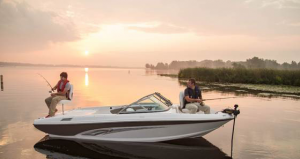Chase The Bait
You’ll start to notice target species such as bass and walleye begin to change their feeding patterns just as the first few waves of crisp fall air sweep across the lakes and rivers. That’s you cue to start paying close attention to the bait fish. Find those little guys and your prey will be somewhere nearby. You’ll have the best luck on large feeder creeks, wide bends and the warmer somewhat shallow runs.
Mimic The Bait
If you know what your target species is currently feeding on, it stands to reason that you want to present either a live or artificial enticement that resembles their normal menu. This can mean a similar size, color and reflectivity. You will notice that while it may take a little more time to get them interested, when your target fish start feeding, they will tend to be more aggressive in attacking the bait. Patience and the remembering to work your bait erratically as you retrieve, will pay off with some big hits. This goes for topwater lures, spinner baits and deeper-diving crankbaits.
Reduce Your Line Test
When you’re fishing slightly deeper waters and you’re seeking out suspended target species at different layers (or strata), consider using a lighter monofilament that usual. This seems to help you not only cast a little further, but the reduced drag will get your bait where it belongs that much quicker. Since this is literally the connection point between you and your prize catch (or supper on the table), make the investment in a quality line. While it’s not as flashy as the latest hyped-up, can’t-miss, 100-percent-guaranteed artificial lure, high-quality monofilament may just save that fancy new lure AND your fish.
Follow The Weather
It goes without saying that you’ll be keeping an eye on the weather when you’re out on the water, but make sure you know what that means to your target species. Bait fish will generally be moving in the same direction as the wind. Knowing that, you can head to the bank (wind blowing directly at you) and start the hunt there. Cooler ambient temperatures will also mean that your fish will be trying to find areas where the water temperatures are somewhat moderated. Constant sun (or shade) either on the north or south side of your body of water will be the best bets.
